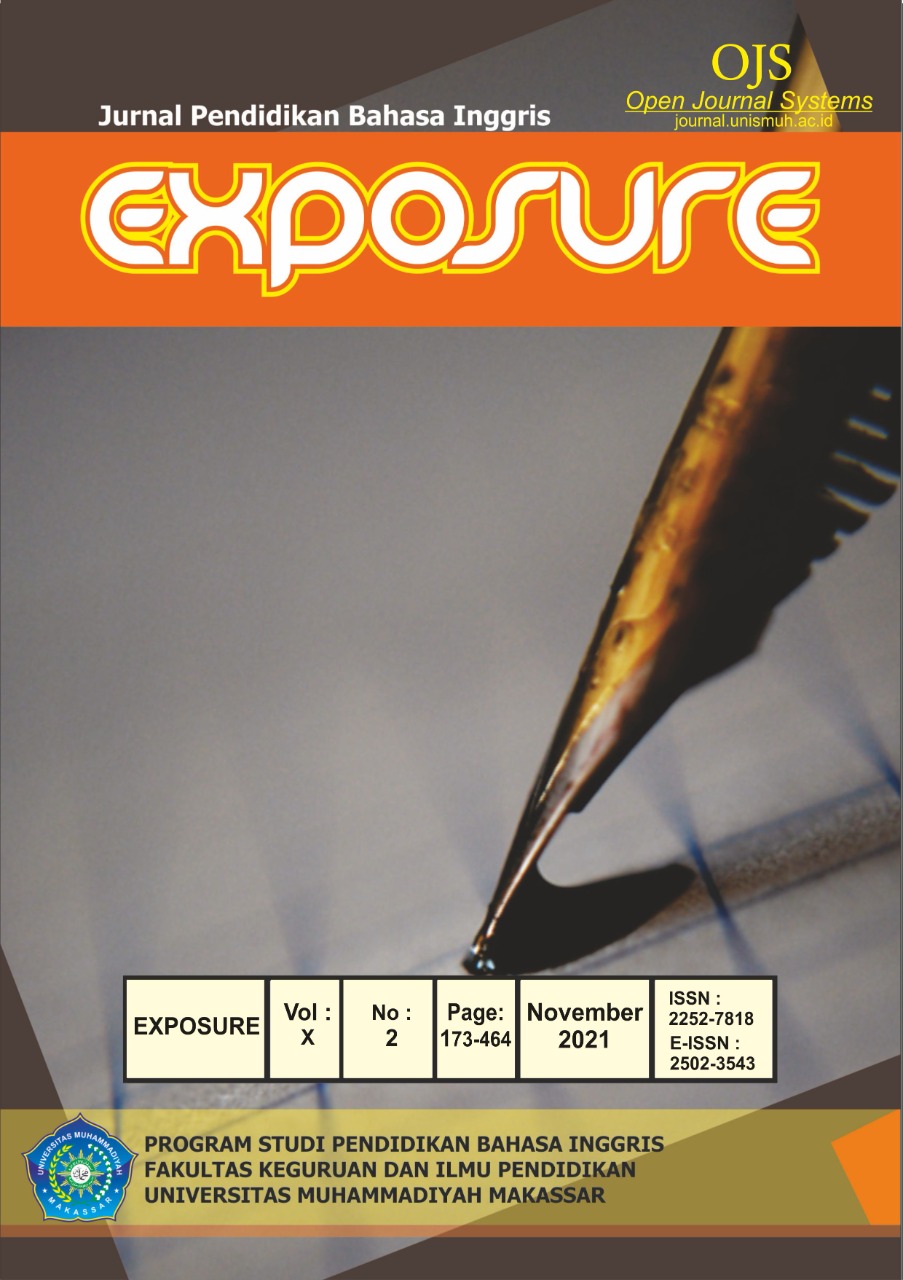IMPROVING STUDENTS’ READING COMPREHENSION THROUGH TOP-DOWN STRATEGY
DOI:
https://doi.org/10.26618/exposure.v10i2.5346Keywords:
Reading Comprehension, Top-Down Strategy, StudentsAbstract
The objective of this research was to find out the improvement of the students’ reading comprehension by using Top-Down strategy in learning reading comprehension at SMA Negeri 1 Wajo. This research employed Pre-experimental method. The population of this research was eight classes of the Tenth grade students at SMA Negeri 1 Wajo in academic year 2019/2020 with the total population were 242 students. The researcher took random sampling and chosen X MIA 1. The data of the research were collected by using the instrument, namely reading test. The result of data analysis showed that there was significant difference between the students’ score after they were taught by top-down strategy and before they were taught by using top-down strategy. It was proved by the mean score of post-test was higher than the mean score of pre-test (67.20>42.56). Furthermore, the result of the p- value (0.00) was lower than α (0.00<0.05) which meant that H1 was accepted.
References
Abdullah. (2009). Improving students’ Reading Ability through English Magazines using Three – Phase Techniques at the second year of SMAN 1 Manggalewa. Thesis Makassar: UNISMUH Makassar.
Anderson. (1985). Becoming a nation of readers (www.ascd.org/publications/educational) Retrieved on May 7, 2013.
Arif, M. (2006). The Effectiveness of using. K-W-L (Know-Want-Learn) Strategy in Improving Reading Comprehension Ability of the Third Year Students of SMA Karya Bulukumba. Thesis Makassar: UIN Makassar.
Brothers, L. (1962). PREP Pre – Reading Evaluation Program. Auckland: Laid Law Publisher.
Ellis. (1996). Prediction – driven computational auditory scene analysis. Ph.D Thesis: Massachusetts Institute of Technology.
Firnawati. (2005). The Using of Top – Down method in Teaching Listening in SMP Muhammadiyah 5 Mariso. Thesis Makassar: UNISMUH Makassar.
Grellet, F. (2010). Developing Reading Skills.New York:Cambridge. University Guilford Press.
Hanaida. (2007). The use of English Newspaper Text Increase the students’ Reading Comprehension at the first grade SMUN 1 Galesong Selatan. Thesis Makassar: UNISMUH Makassar.
Klingner, J., K., Sharon, V., and Alison, B. (2007). Teaching Reading Comprehension to Students with Learning Diffculties. New York: The Guildford Press.
Lingzhu, Ji. (2003). Listening activities for effective top – down processing
(http://itesl.org/techniques/lingzhu) Retreived on May 5,2013.
Mustamin, N. (2010). Teaching Reading Comprehension by Using English Magazine articles at the first year students of MA Muhammadiyah Wajo, Thesis Makassar: UNISMUH Makasssar.
Nunan. (1991). Language Teaching Methodology. Hertfordshire: Prentice hall international.
Soleimani, H. (2013). The Effect of Teaching Reading Comprehension Strategies on Iranian EFL Pre-University Students' Reading Comprehension Ability.(http://www.irjabs.com/files_site/paperlist/r_1485_130921171625.pdf). Retrieved May 10 th, 2015.
Downloads
Published
Issue
Section
License
Authors who publish with this journal agree to the following terms:
In order to assure the highest standards for published articles, a peer review policy is applied. In pursue of the compliance with academic standards, all parties involved in the publishing process (the authors, the editors and the editorial board and the reviewers) agree to meet the responsibilities stated below in accordance to the Journal publication ethics and malpractice statement.
Duties of Authors:
- The author(s) warrant that the submitted article is an original work, which has not been previously published, and that they have obtained an agreement from any co-author(s) prior to the manuscript’s submission;
- The author(s) should not submit articles describing essentially the same research to more than one journal;
- The authors(s) make certain that the manuscript meets the terms of the Manuscript Submission Guideline regarding appropriate academic citation and that no copyright infringement occurs;
- The authors(s) should inform the editors about any conflict of interests and report any errors they subsequently, discover in their manuscript.
Duties of Editors and the Editorial Board:
- The editors, together with the editorial board, are responsible for deciding upon the publication or rejection of the submitted manuscripts based only on their originality, significance, and relevance to the domains of the journal;
- The editors evaluate the manuscripts compliance with academic criteria, the domains of the journal and the guidelines;
- The editors must at all times respect the confidentiality of any information pertaining to the submitted manuscripts;
- The editors assign the review of each manuscript to two reviewers chosen according to their domains of expertise. The editors must take into account any conflict of interest reported by the authors and the reviewers.
- The editors must ensure that the comments and recommendations of the reviewers are sent to the author(s) in due time and that the manuscripts are returned to the editors, who take the final decision to publish them or not.
Authors are permitted and encouraged to post online a pre-publication manuscript (but not the Publisher’s final formatted PDF version of the Work) in institutional repositories or on their Websites prior to and during the submission process, as it can lead to productive exchanges, as well as earlier and greater citation of published work (see The Effect of Open Access). Any such posting made before acceptance and publication of the Work shall be updated upon publication to include a reference to the Publisher-assigned DOI (Digital Object Identifier) and a link to the online abstract for the final published Work in the Journal.

